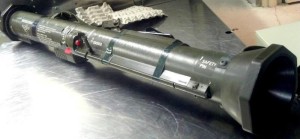 PART THREE – HIT MEN FOR HOT ZONES
PART THREE – HIT MEN FOR HOT ZONES
Killers for hire on both sides of the border
An assault on the San Onofre Nuclear Generating Station (SONGS) spent fuel pools (SFPs) buildings depends on the availability of rocket launchers and the people who would use them. Such a dangerous scheme, however remote but a possibility, would also have to have a motive. All three conditions are present at San Onofre. Rocket launchers are available on both sides of the border, terrorist attackers are for hire in America and Mexico, and a range of motives includes jihad and anger at the U.S. government.
Rocket launchers are common enough on American streets that in January one showed up at a Trenton New Jersey gun buyback program held over two days. The fired weapon appeared to be an AT-4. Earlier in January, at another police buyback in Seattle Washington, a far more advanced shoulder-fired rocket launcher showed up to be exchanged for $250. A fired and now-empty Stinger rocket launcher mystified the police who said they would investigate whether it had been stolen or not.
The Los Angeles Police Department obtained two rocket launchers in December 2012, one being an AT-4, at a gun exchange for supermarket gift cards. The LAPD, in perhaps the most counterintuitive stroke imaginable, stiffed the rocket launcher owners for the gift cards. “Those are weapons of war, weapons of death,” Chief Charlie Beck said according to the Los Angeles Times. “[T]hey have no place in our great city.”
Rocket launchers have no place in neighboring San Bernardino County either according to the San Bernardino Police Department. A Vagos motorcycle gang takedown of its upper echelon September 29, 2011 resulted in the seizure of meth, cocaine and hundreds of weapons including an AT-4 rocket launcher and an anti-tank gun according to the San Bernardino Sun. California Attorney General Kamala D. Harris’ office said the Vagos gang was a transnational criminal organization operating in the U.S., Mexico, Puerto Rico, Canada, Germany and New Zealand.
The threat of unaccounted for rocket launchers floating around isn’t just a danger on this side of the border. Mexico’s drug lords have been loading up on heavy weaponry including narco tanks and their own arsenal of rocket launchers according to multiple media stories.
Time magazine reported “three Soviet-made antitank rockets complete with an RPG-7 shoulder-fired launcher” were seized by a Mexican SWAT team from a drug lord near the border town of Piedras Negras across the Rio Grande from Eagle Pass, Texas in 2012. The rockets, which can reach up to 3,000 feet, are not likely to be able to inflict the kind of damage on SONGS’ exposed SFPs as the weapons and seem more suited to tank and armored car attacks.
According to Time, “almost 100,000 guns seized at Mexican crime scenes since 2007, 68% have been traced to the U.S.” American guns and cash heads south as Mexican drugs and muscle head north.
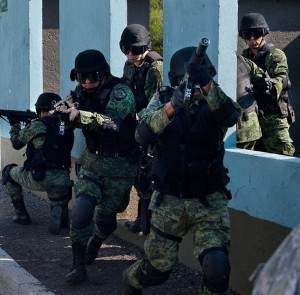 The drug war in Mexico intensified in 2006 when then-President Felipe Calderón’s government ordered the military to take on the narco traffickers responsible for about 90 percent of the cocaine smuggled into the United States. That illicit business, estimated to be worth up to $49.4 billion annually according to multiple sources, has been plunged into a drug war that has resulted in the deaths of between 60,000 to 100,000 Mexicans, many from gruesome beheadings.
The drug war in Mexico intensified in 2006 when then-President Felipe Calderón’s government ordered the military to take on the narco traffickers responsible for about 90 percent of the cocaine smuggled into the United States. That illicit business, estimated to be worth up to $49.4 billion annually according to multiple sources, has been plunged into a drug war that has resulted in the deaths of between 60,000 to 100,000 Mexicans, many from gruesome beheadings.
It also has left Mexico awash in weapons and the violent men that use them. Mexican marines busted nine alleged drug cartel members in Coahihuila last November and the haul was substantial. Heaps of guns, pot, cocaine, meth and cash were displayed under heavy guard. Suspected cartel members stood silent and sheepish behind the arsenal which included 30 rocket-propelled grenade launchers.
The Iran-Cartel Connection
Could this vast pool of hit men and rocket launchers be used to threaten the United States by its enemies in places like, for example, the Middle East? The answer is yes according to the Federal Bureau of Investigation.
The FBI busted a conspiracy in 2011 it says began with the Iranian government attempting to put a hit on the Saudi Arabian ambassador to the United State in this country using Mexican cartel hit men. The agency revealed the plot October 17, 2012 when the lead conspirator, Manssor Arbabsiar, pleaded guilty in federal court in the Southern District of New York to conspiring with Iranian military officials to assassinate the ambassador.
The plan was to pay four cartel gunmen $1.5 million to take out the ambassador at one of his favorite Washington D.C. restaurants regardless of the collateral damage. Arbabsiar didn’t realize he was dealing with a wired undercover American government agent when he admitted that he was recruited, funded and told what to do by senior officials in Iran’s Qods Force.
This 15,000-strong special unit of Iran’s Army of the Guardians of the Islamic Revolution is responsible for “exporting” the revolution according to Robin Wright’s 2008 book Dreams and Shadows: the Future of the Middle East. The Federation of American Scientists Intelligence Resource Program says that the Qods Force is responsible for the Revolutionary Guard’s “extraterritorial operations.” Several sources say that the elite spy and terrorist network answers directly to Iran’s Supreme Leader Ali Khamenei.
“They want that guy [the Ambassador] done [killed],” Arbabsiar told the undercover agent who supposedly would recruit the cartel killers. Regarding innocent bystander casualties reportedly Arbasiar said “[I]f the hundred go with him fuck ‘em.”
“The dangerous connection between drug trafficking and terrorism cannot be overstated, and this case is yet another example of DEA’s unique role in identifying potentially deadly networks that wish to harm innocent Americans and our allies worldwide,” said Drug Enforcement Agency Administrator Michele Leonhart. “Using DEA’s elaborate and sophisticated investigative expertise to infiltrate violent drug and terror organizations globally, we successfully identified this threat and worked closely with the FBI to prevent a potentially deadly outcome.”
A year earlier, a then 26 year old New Jersey man who had joined al-Qaeda tried to shoot his way out of a Sanaa, Yemen hospital killing one and injuring several others before being cornered and captured by Yemini special forces. Sharif Mobley had worked at five different nuclear power plants between 2002 and 2003 including Peach Bottom and Three Mile Island.
Just last week, an Orange County man was pulled off a bus bound for Mexico where he had hoped to join al-Qaeda as a soldier. Federal agents busted Sinh Vinh Ngo Nguyen for make false statements on his passport and trying to support al-Qaeda. Nguyen had changed his name to Hasan Abu Omar Ghannoum after converting to Islam and allegedly trying to join the terrorist group. “I’m doing well in Syria,” Ghannoum wrote on his Facebook page in January. “[H]aving a blast here, and I mean literally.”
It isn’t always easy or obvious who the potential fanatic is going to be. The terrorist attack scenarios exposed in EnviorReporter.com‘s Black Swan SONGS series are deadly outcomes that must be prevented 100 percent of the time. Destruction of spent fuel rods and releasing thousands of units of intensely lethal radiation into the environment cannot be explained away by hopeful rationalization or dubious statistics. A nation can be brought to its knees by the realistic situations explored herein. It is far easier to prevent a black swan event than it is dealing with its consequences.
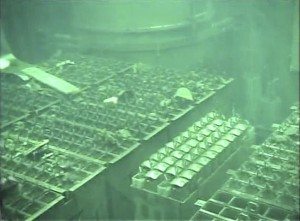 EnviroReporter.com‘s revelations are not going to be news to many people familiar with the destructive potential of a terrorist attack on SFPs – international concerns over Fukushima’s Unit 4 SFP has been widespread. People, including terrorists, cartel members and state-sponsored agents, have a constant reminder in Fukushima of the potential destruction of a spent fuel pool would cause.
EnviroReporter.com‘s revelations are not going to be news to many people familiar with the destructive potential of a terrorist attack on SFPs – international concerns over Fukushima’s Unit 4 SFP has been widespread. People, including terrorists, cartel members and state-sponsored agents, have a constant reminder in Fukushima of the potential destruction of a spent fuel pool would cause.
Companies that own nuclear facilities like San Onofre have no financial incentive to have a robust force on force-ready security setup that would protect the region from an organized terrorist attack. In SONGS’ case, the strategic attraction of targeting the spent fuel pools would include making a huge Marine base uninhabitable.
Any country planning military strikes has even more reasons to best know its most serious weaknesses before launching such a venture. The spent fuel pools at San Onofre and others around the country are just such weaknesses depending on location and a variety of factors. These flaws could be ironed out fairly quickly at SONGS because of its unique military environment. World events necessitate that the nation’s armed forces take these threats seriously.
‘You have to expect everything’
Just last month, America was headed for war with Syria, a wily adversary whose allies include Iran. A belligerent pre-UN diplomatic deal Bashar al-Assad told Le Figaro in late August that anything can happen if his forces are attacked. “Once the barrel explodes, everyone loses control; nobody can determine the outcome, however what is certain is the spread of chaos, wars and extremism in all its forms everywhere,” al-Assad said. “[I]t is impossible to separate the interests of Syria, Iran, Hezbollah and other countries that are supporting us.”
“If you strike somewhere, you have to expect the repercussions somewhere else in different forms in a way that you don’t expect,” al-Assad told CBS This Morning co-host Charlie Rose in his first television interview since Obama sought in vain congressional approval for a limited and targeted strike on Syria. “You should expect everything. No–not necessarily through the government … But nobody expected the 11th of September. You have to expect everything.”
The de-escalation of a possible US-Syrian military engagement does not of course remove the threat of attacks against the United States. Even in light of the phone call between Iranian President Hassan Rouhani and American President Barack Obama during the Iranian leader’s trip to the United Nations in New York City in September, the Islamist country is still singing the same tune. “We support the government’s diplomatic moves including the New York trip because we have faith (in them),” said Iran’s supreme leader Ayatollah Ali Khamenei to commanders and graduating military cadets in Tehran October 5. “But some of what happened in the New York trip was not appropriate,” a thinly veiled allusion to the phone call between the two presidents.
“We are skeptical of Americans and have no trust in them at all,” Khamenei continued. “The American government is untrustworthy, arrogant, illogical and a promise-breaker. It’s a government captured by the international Zionism network.”
The threat of Iranian terrorism is not lessened with words like these. The possibility of State-sponsored terrorism using cartel members with their ties with American gangsters is not something to take lightly.
Cartel Soldiers
Nowhere in the country is a nuclear reactor complex more vulnerable to a terrorist attach than the San Onofre Nuclear Generating Station. SONGS’s spent fuel pools buildings are vulnerable to enemies of the United States using cartel soldiers as their apolitical terrorists for hire. The weapons and men are available in a land 70 miles away where brutality is law in the raging drug war. Dangerous men are available for a price in drug country – a price Iran, al-Qaeda and other enemies of the United States have the means to pay.
 Cartel-linked hired guns exist on both sides of the border according to numerous sources. Cartels especially like trained U.S. soldiers according to a FoxNews.com article August 1. A former Army private, Michael Apodaca, was sentenced to life in El Paso July 25 for executing a cartel hit for $5,000 in the border city May 15, 2009. A former Army sergeant who served in Afghanistan was sentenced to 15 years in prison June 21 for a murder-for-hire killing.
Cartel-linked hired guns exist on both sides of the border according to numerous sources. Cartels especially like trained U.S. soldiers according to a FoxNews.com article August 1. A former Army private, Michael Apodaca, was sentenced to life in El Paso July 25 for executing a cartel hit for $5,000 in the border city May 15, 2009. A former Army sergeant who served in Afghanistan was sentenced to 15 years in prison June 21 for a murder-for-hire killing.
Last September a former active-duty first lieutenant pleaded guilty to conspiracy to commit murder in Laredo after offering his services to what he thought was a cartel member. Kevin Corley, 29, from Fort Carson in Colorado offered tactical training for cartel soldiers and to buy weapons for them. Corley discussed military tactics with the undercover agent and said he would rip off the weapons from military posts. After agreeing to a cartel hit for $50,000 and cocaine, Corley was arrested Dec. 23, 2011.
Cartels know that the U.S. military has prospective recruits who have gang backgrounds or join gangs once in the service. The FBI National Gang Intelligence Center has identified at least 53 gangs affiliated with the American armed forces.
“There has been a persistent gang problem in the military for the past six to eight years,” said Fred Burton, vice president for STRATFOR Global Intelligence to FoxNews.com, who added that cartels want trained soldiers from the U.S. as hit men. “It is quite worrisome to have individuals with specialized military training and combat experience being associated with the cartels.”
It is also quite worrisome when the Mexican Mafia prison gang and La Familia Michoacána drug cartel hook up “to protect and expand the cartel’s drug trafficking activities across the nation,” according to an August 6 press release from the U.S. Attorney’s Office, Central District of California, announcing the arrest of eight suspects named in a federal grand jury indictment. A second indictment simultaneously unsealed exposed the Mexican Mafia’s control over one of the oldest, largest and most powerful gangs in Southern California. The indictment charged 31 suspects with federal racketeering (RICO) along with numerous narcotics, fraud and firearms offenses.
 “These two investigations disrupted the criminal activities of the Mexican Mafia, the Los Angeles street gang Florencia 13, and the Mexican Mafia’s relationship with the La Familia drug cartel, which is responsible for using firearms to commit violent crimes and trafficking hundreds of thousands of pounds of controlled substances into the United States,” said Steven J. Bogdalek, ATF Special Agent in Charge of the Los Angeles Field Division. “By combining law enforcement resources, we were able to curtail their ability to build alliances and prevent their violence from spreading further into our communities.”
“These two investigations disrupted the criminal activities of the Mexican Mafia, the Los Angeles street gang Florencia 13, and the Mexican Mafia’s relationship with the La Familia drug cartel, which is responsible for using firearms to commit violent crimes and trafficking hundreds of thousands of pounds of controlled substances into the United States,” said Steven J. Bogdalek, ATF Special Agent in Charge of the Los Angeles Field Division. “By combining law enforcement resources, we were able to curtail their ability to build alliances and prevent their violence from spreading further into our communities.”
The feds and local law enforcement then moved their Mexican Mafia eradication campaign south to Orange County where a September 24 raid scooped up 55 suspects, 22 pounds of meth, 1.5 pounds. of heroin and three pounds of coke. Operation Smokin’ Aces, led by the FBI along with Santa Ana police, Orange County Sheriff detectives, Orange County district attorney’s office and other agencies targeted the Mexican Mafia’s affiliated gangs, focusing on Santa Ana. The Mexican Mafia’s Orange County chapter is largely made up of established gangs like Delhi, F Troop, Townsend Street and Santa Nita according to law enforcement officials.
While the Americans were putting the cuffs on cartel soldiers north of the border, Mexico was releasing a legendary cartel kingpin south of it over U.S. objections. The freeing of one of the founding members of Mexico’s first and largest drug cartels, Rafael Caro Quintero, 60, came August 9. Having served 28 years of a 40 year sentence, Quintero strolled out of a Jalisco state prison after a Mexico federal court ordered his release because he had been improperly tried.
“The release of this violent butcher is but another example of how good faith efforts by the U.S. to work with the Mexican government can be frustrated by those powerful dark forces that work in the shadows of the Mexican ‘justice’ system,” the Association of Former Federal Narcotics Agents in the United States said in a statement. The group was “outraged” by the release of Caro Quintero who had been sentenced to 40 years in prison for the infamous kidnapping and killing U.S. Drug Enforcement Administration agent Enrique Camarena.
Pernicious criminality exists on both sides of the border. It destabilizes otherwise peaceable people and their communities along the divide. It is even more shocking when it involves the U.S. Marine Corps, especially on the very base that SONGS is situated.
That’s just what happened June 6 when the Corps revealed that Camp Pendleton Marines were busted in what was called Operation Perfect Storm. The Naval Criminal Investigative Service, assisted by the San Diego County Regional Automobile Theft Task Force, Homeland Security Investigations and the FBI, handed down 64 indictments of active-duty and former Marines and “confiscated one million dollars’ worth of contraband in connection with an organized crime ring.”
Meth, coke, and ecstasy were confiscated from the suspects along with “enhanced small arms protective insert plates, tactical vests, M-40 gas masks, tool kits, high capacity magazines, 10,000 rounds of 5.56 millimeter ammunition, thermal monoculars, night vision goggles, semi-automatic rifles, shotguns, pistols, U.S. currency, and 92 stolen automobiles,” according to HQ Marine Corps. “Seven Marines, one sailor and seven Marine veterans have been implicated, ranging in rank from lance corporal to gunnery sergeant.”
At least there were no rocket launchers or C-4 explosives involved. That wasn’t the case September 15, 2011 when U.S. Customs and Border Protection officers found a black bag containing a rocket launcher, a grenade launcher, six semi-automatic assault rifles and three bags of C-4 plastic explosives along the Rio Grande River south of San Antonio. The Border Patrol speculated that the weapons and explosives were destined for feuding cartels south of the border.
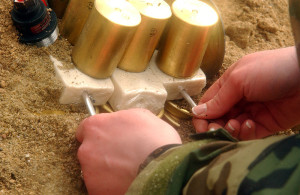 Knowing what resources these potential terrorist proxies possess changed entirely with the seizure of C-4 at the border. San Onofre is uniquely vulnerable to attack from C-4 explosives among nuclear reactor and spent fuel pools installations in the United States. Along with attack from rocket launchers on the exposed spent fuel pools buildings, a C-4 strike against SONGS’ lightly defended dry casks filled with spent fuel rods present the most dangerous and plausible scenarios to threaten San Onofre’s destruction and Southern California’s along with it.
Knowing what resources these potential terrorist proxies possess changed entirely with the seizure of C-4 at the border. San Onofre is uniquely vulnerable to attack from C-4 explosives among nuclear reactor and spent fuel pools installations in the United States. Along with attack from rocket launchers on the exposed spent fuel pools buildings, a C-4 strike against SONGS’ lightly defended dry casks filled with spent fuel rods present the most dangerous and plausible scenarios to threaten San Onofre’s destruction and Southern California’s along with it.
Backpack Black Swan
Nightmarish scenarios such as a 9/11-type jetliner crashing into SONGS have gotten the attention of government and nuclear watchdogs alike. The concerns are legitimate.
Seeing the precision with which the 9/11 hijackers piloted huge jets into the World Trade Center, it is no great stretch imagining a private prop plane loaded with high-yield explosives crashing into one of America’s nuclear reactor complexes. This threat has not been addressed as there are nearly no airspace restrictions on small planes near nuclear reactor complexes.
EnviroReporter.com has discovered a second major security weakness at the San Onofre Nuclear Generating Station during a four month long investigation that doesn’t take a rocket launcher or pilot’s license. It does take running and climbing ability along with a bag of powerful plastic explosives and plenty of nerve.
Even with their massive steel and concrete containers, the dry cask storage of spent nuclear fuel rods at SONGS is vulnerable to terrorist attack. San Onofre’s Independent Spent Fuel Storage Installation (ISFSI) is another black swan waiting to land.
So glaring is this weak spot that a terrorist team on foot with plastic explosive-filled backpack bombs could run right up next to the lightly defended containers and set off an explosion that could severely damage the casks if not destroy them entirely. This would result in a huge release of highly radioactive material into the environment.
These weaknesses are visible to anyone who works at SONGS or just drives by the site on Old Highway 101 on their way to the San Onofre State Beach. Internet resources abound with information and photos on the layout of San Onofre that show this failing.
What caught EnviroReporter.com‘s attention was Los Angeles Times coverage June 7 of victorious residents on the Old Highway 101 sidewalk above the reactors by the parking lot to SONGS. They were celebrating the just announced shutdown of San Onofre. The article’s photo showed light perimeter security at the employees’ parking lot up the concrete covered bluff from the SONGS ISFSI.
Photographic and video analysis, with some of the information publicly available from Southern California Edison itself, reveal what seems to be another glaring security breech in addition to the rocket attack-vulnerable spent fuel pool buildings or SFPs. Further investigation on Google Maps and Google Earth confirmed that security for the dry cask spent fuel is light.
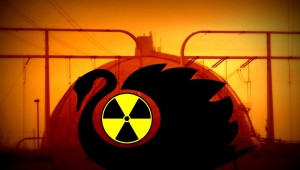 From the sidewalk, a backpack terrorist unit could easily scale a six-foot chain-link fence between the sidewalk and parking lot, snip through or jump a minimally barbed wire fence on the other side of the parking lot above two steep concrete inclines. Scampering down these unguarded inclines leads to the dry casks storage which is “750 feet northwest of the reactor buildings and outside the plant’s security perimeter but within its own controlled area,” according to StoreNuclearFuel.com.
From the sidewalk, a backpack terrorist unit could easily scale a six-foot chain-link fence between the sidewalk and parking lot, snip through or jump a minimally barbed wire fence on the other side of the parking lot above two steep concrete inclines. Scampering down these unguarded inclines leads to the dry casks storage which is “750 feet northwest of the reactor buildings and outside the plant’s security perimeter but within its own controlled area,” according to StoreNuclearFuel.com.
That dry cask controlled area also has a minimally barbed wire fence unlike the controlled area with its heavy concertina barbed wire and guard post. The SFPs are within this high security area. The dry casks are not. EnviroReporter.com estimates that a backpack bomber or bombers could surmount the three fences and be standing next to the 55 storage modules in less than two minutes.
There they would find the SONGS ISFSI with dry casks. Sitting on a storage pads 43 feet wide and 293 long are 31 casks with an adjacent 24 casks in double rows on a pad 60 feet wide. The installation appears to have no permanent guards in or around the ISFSI.
An athletic terrorist team with just 100 pounds or more of C-4 explosive and detonators could cause a catastrophic ISFSI explosion in a matter of minutes. The attackers could stuff the malleable C-4 into the structures nooks and crannies for added destruction. War videos demonstrate the power of such a charge making the relative ease of attack, on a Marine Corps base no less, unacceptable – especially considering the consequences.
The Nuclear Regulatory Commission’s consistently dismissive policies on the threat of terrorist attack on spent fuel rods, whether in dry casks or the more exposed spent fuel pools, seem at odds with the threat. Indeed, the NRC even has a detailed map of ISFSIs nationwide online as if to advertise the radiating targets as benign.
Missing C-4 explosives
An attack of a squad of C-4 explosive backpack-toting bombers against SONGS’ ISFSI would probably not be as destructive as a rocket attack against San Onofre’s SFPs. It nevertheless represents a real black swan possibility with the unknown amounts of C-4 explosives that have ‘gone missing’ all over the country and some of the people busted for possessing them.
The last available General Accounting Office reports on missing C-4 are decades old as far as EnviroReporter.com could find but are still informative as the explosive does not degrade and has an indefinite shelf life. A November 1986 GAO report focused on Fort Bragg’s lax C-4, ammunition and explosives security. The North Carolina U.S. Army base is home to The Airborne and Special Operations Forces.
The Bureau of Alcohol, Tobacco, and Firearms recovered 21 bricks of 1.25 pounds per brick of C-4 in Hope Mills, North Carolina June 9, 1986. The M112 blocks were traced to two active service members assigned to Fort Bragg’s Fifth Special Forces Group. That same year a Fort Bragg employee found six one-pound blocks of C-4 in a green Army cloth bag in a wildlife feeding area. Fiscal year 1986 must have been a banner time for ripping off C-4 at the fort with 147.5 pounds of it recovered up from 34 pounds seized in FY 1985.
Beginning in 1988, the Army tried to suppress the thievery by swapping out C-4 with inert training material. It eliminated entirely the following units from even being able to train with the explosive: aviation, ordnance, chemical, military police, transportation, signal, accounting and finance, quartermaster and, interestingly, military intelligence. Still, C-4 was allowed to be used by armor, infantry, combat engineers and combat heavy engineer units,
Even then, the thievery of C-4 has continued up through today. Oft times, soldiers would return the empty C-4 boxes to the quartermaster after training as the way to keep track of inventory. The boxes may have been returned but the explosives not detonated allowing the C-4 to have “gone missing.”
Another GAO study came out in September 1990 entitled “DEFENSE INVENTORY – Controls Over C-4 Explosive and Other Sensitive Munitions.” The report said that “3.76 pounds of C-4 explosive were lost by the Air Force with 2.6 pounds of C-4 explosive being recovered from 1986 through 1989… The Navy reported that between 1986 and 1989, 80 pounds of C-4 were lost, 440 pounds of C-4 were missing following inventories, and 460 pounds of C-4 were recovered.”
While the GAO’s Navy C-4 inventory math is mystifying, it is the last U.S. government C-4 accounting that EnviroReporter.com could uncover as of publication time. This very powerful plasticized form of Research Department Explosive (RDX) comes in 1.25 pound (lb) blocks 2 inches by 1.5 inches and 11 inches long.
The blocks are wrapped in Army green packaging with M112 stamped on the plastic. Besides being extremely explosive, an M112 brick is safe to handle and won’t detonate because of dropping it or even setting it alight. Vietnam-era soldiers used to cook with it despite C-4’s toxic fumes.
 Sixteen of these M112 demolition charges are bundled together into a 20 lb (9.1 kilogram-kg) C-4 satchel charges called the U.S. M183 Demolition Charge Assembly. Four priming assemblies come with the M183 which is stable in storage and carries the most bang and brisant – its shattering ability determined mostly by its detonation pressure – for a lot of bucks if not obtained on the black market from potentially thieving American soldiers.
Sixteen of these M112 demolition charges are bundled together into a 20 lb (9.1 kilogram-kg) C-4 satchel charges called the U.S. M183 Demolition Charge Assembly. Four priming assemblies come with the M183 which is stable in storage and carries the most bang and brisant – its shattering ability determined mostly by its detonation pressure – for a lot of bucks if not obtained on the black market from potentially thieving American soldiers.
A terrorist team with multiple M183’s is SONGS’ ISFSI’s most acute plausible threat. Obtaining the explosive on the streets or military bases of America is far from impossible since the GSA’s 24 year old report. Wars in Iraq and Afghanistan have produced sticky fingered Army Special Forces men who have stolen C-4 and have been busted for it.
Staff Sgt. Trey Scott Atwater, a demolitions expert and unconventional warfare specialist with the 7th Special Forces Group at Fort Bragg, was popped carrying two M112s of C-4 in his carry-on bag in Midland Texas December 31, 2011. The Green Beret, who had serve two tours of duty in Afghanistan, claimed he didn’t know the 2.5 lbs of plastic explosive in its Army wrapping was in his bag, stuffed between the padding and bag in the backpack’s lumbar area.
This was the same backpack in which Atwater was carrying a military smoke grenade when he was stopped by TSA security in Fayetteville, North Carolina’s airport a week earlier, December 24. Atwater was scolded and his smoke grenade taken away but was still allowed to travel to Texas presumably with a bag full of enough C-4 to blow the jet he got on out of the sky.
It’s clear the C-4 was in Atwater’s backpack after the smoke grenade incident because when he was busted for the plastic explosive on New Year’s Eve, his excuse was that he forgot about it since coming back from Afghanistan the previous April. The Green Beret didn’t say why he had the C-4 or why he would have had to illegally smuggle it out of a war zone to possess it. Atwater was mum on why he had a military smoke grenade his backpack or why he had brought this small arsenal on a public aircraft and forgot about the C-4 even after getting caught with the smoke grenade. In the end, though, he didn’t have to explain anything: all charges were dropped in February 2012.
Another Army Special Forces soldier was arrested at home in Clarksville, Tennessee on November 2, 2009 for having 100 pounds of C-4. The soldier’s house was near Fort Campbell, Kentucky, where he was stationed. Two hunters had found the hefty C-4 stash in a bag in a field linked to the Special Forces sergeant.
In another incident, a ten pound cache of C-4 was found by a caretaker at the New York City Marble Cemetery in spring 2009. The eight M112 demolition charges in a crumbling black garbage bag were good to go even though lack of taggants – identifying markers – dated the production of the C-4 to before 1997.
Exactly how much C-4 has been stolen from the military or civilian businesses in the United States is a mystery. Anecdotal information serves as a key indicator barring such estimates.
One of the biggest heists of explosives in New Mexico history went down sometime in December 2005 when 400 pounds of plastic explosives, including 150 lbs. of C-4, were ripped off. The thieves used a blowtorch to cut into several storage trailers of Cherry Engineering outside of Albuquerque.
The company’s owner, Chris Cherry, was a scientist at the time of the theft with Sandia National Laboratories. This was the second theft in two years at the unguarded site with no surveillance cameras. Officials said that there was enough explosive to equal the 1995 Oklahoma City federal building bombing and that they had no leads.
“There is no specific threat,” then Governor Bill Richardson said in a written statement, adding that “it is my understanding that the explosives were stolen from a private magazine.”
Somehow Richardson seemed to imply that things were okay. One Rand Corp. terrorism expert told CNN that these thefts were common with around 100 per year in the 1990s with most having to do with organized crime, insurance fraud, extortion, personal vendettas, vandalism, revenge and protest. It is not reassuring that terrorism wasn’t the motive for stealing from unsecure sites.
Law enforcement has repeatedly taken down people trying to sell or buy C-4. It is illegal for most civilians to own C-4 in the U.S. That didn’t stop two men and a woman in Bradford Pennsylvania from trying to sell a M112 brick to a confidential police informant in early November 2012. One of the men had absconded with the 1.25 pound C-4 from his employer two months earlier at his well blasting business. For their troubles the trio was jailed on $250,000 bail.
The U.S. Attorney’s Office in Cleveland announced May 1, 2012 that they had busted five men conspiring to use C-4 to blow up a bridge outside of the city. The self-proclaimed anarchists wanted to place two improvised explosive devices under the Route 82 Brecksville-Northfield High Level Bridge which crosses over the Cuyahoga Valley National Park, according to the complaint. The pair didn’t realize that the “C-4” they were being sold was inert putty placed in their hands by undercover agents.
 Throwing themselves at the mercy of the court ended up being a successful move but came at the cost of some grandiose public groveling. One of the would be terrorists, Brandon Baxter, 20, got 117 months instead of the prosecutor-recommended 300 months after his defense attorney John Pyle laid it on thick.
Throwing themselves at the mercy of the court ended up being a successful move but came at the cost of some grandiose public groveling. One of the would be terrorists, Brandon Baxter, 20, got 117 months instead of the prosecutor-recommended 300 months after his defense attorney John Pyle laid it on thick.
“The government has every right, every duty to trap terrorists,” Pyle proclaimed. “I don’t dispute that for one second. I grew up in a country where farmers trap destructive rodents; they sometimes trap curious cats. Brandon Baxter is more a curious stray cat than a destructive rodent.”
SONGS is not vulnerable to stoner stray cats. It is vulnerable to all manner of foreign and domestic criminal and terrorist conspirators simply because the targets are not heavily protected and are of high value. This series has established that the threat is abundantly real with the weapons, explosives and personnel available for such a black swan attack. Killers from around the world are available for the right ideology or the right price or both.
A chilling example of this was the September 27 bust of three ex-soldiers accused of plotting to kill a Drug Enforcement Agency agent for $800,000. Alleged ringleader Joseph “Rambo” Hunter, 48, bragged to undercover DEA agents that he could handle protecting drug shipments and assassinations with his team of snipers. Hunter supposedly told the agents that he became a contract killer after serving in the U.S. Army from 1983 to 2004.
“The bone-chilling allegations in today’s indictment read like they were ripped from the pages of a Tom Clancy novel,” U.S. Attorney Preet Bharara said at a press conference. “The charges tell a tale of an international band of mercenary marksmen who enlisted their elite military training to serve as hired guns for evil ends.”













You called this three months ago. Serious validation – “Clapper Says Syrian Al-Qaida Wants to Attack US” http://abcnews.go.com/Politics/wireStory/clapper-syrian-al-qaida-attack-us-22283284
Thank you for having the guts to report this. Maybe the Marines or anti nuke people will see that this threat is real and get off their butts and protect those nuclear rod pools.
Seems like people serious about terrorism – the George C. Marshall European Center for Security Studies – take this article seriously. Their PTSS Daily Counterterrorism News Journal featured it at https://globalecco.org/documents/10180/452548/PTSS+Daily+17+10+2013.pdf/18883adf-e4cc-4f90-88f3-3f2abe856007
The U.S. and German defense departments created this security and terrorism studies institute in 1993. Glad to see this part of DOD taking a look at this because defeating the threat is practical and essential. It is a threat on both sides of the Atlantic that can’t be ignored any longer.
Well, this is all very unsettling. The ready availability of powerful explosives and military arms is not surprising to me at all. I can understand why drug lords can be particularly vicious when it comes to protecting turf, eliminating rivals and using mercs to secure their operations. And, for a price, these professional mercenaries might well eliminate a chosen soft target for monetary gain. That said, I do not believe it would make any business sense for cartels or their hires to lay waste to SONGS, contaminating a lucrative market area for their usual wares. Their is no motive for that crowd to cr*p in their own back yard, so to speak. Rather, it is the ideologues who might choose an extremely messy target, such as SONGS, most likely in retaliation for U.S. activities elsewhere (such as intervention in Syria or Iran). The fact that powerful weapons or explosives might be sold to such groups from local suppliers, greatly simplifies the logistics of transporting said weapons and explosives to the attack site. I wouldn’t be surprised if such a potential attack were supplied directly from weapons stolen from the Camp Pendelton Marine base, itself. So rather than being protective to SONGS, the nearby Marine base, is actually the most likely supply source for weapons and explosives the attackers need to accomplish their nefarious aims. I think I could write a creditable B-grade TV script thriller about such a plan. Let’s hope such ideas do not become an actuality in a terrorist’s mind. Is it responsible to merely hope for the best, though? The target risk is there, the weapons are nearby, so many military personnel who might become theives when tempted by mounds of cash…
Sleep well, dream of something pleasant, sheep, perhaps. Just remember, there may be a wolf lurking among them. Or is it a Black Swan?
Have your geiger counters fully functioning.
This is so shocking I don’t even know where to begin. Actually I do. The wingnuts who have commented so far show just how nuts conspiro’s really are. It’s likely that they couldn’t even understand this monumental work. Enviroreporter has done the job our government should be doing. What I find really impressive is how you covered all the bases showing how credible the threat of attacking San Onofre, Peach Bottom and the other hundred or so pre-placed terrorist targets really is. Instead of just scaring the pants off of us, you’ve also hinted at the solutions which I gather are in the next piece. I can’t wait to read it! Thank you Enviroreporter! You really have done commendable work that is a credit to your profession and our country. Now the government must ACT now that the wingnuts who shut it have been show the door.
In the days of old when they dug up the gold, the great equalizer was the Colt .45 Nowadays the great equalizer is RPG.
The launchers are actually legal to own in the US, but the propelled grenades surely are not. But, for the right price and the right reasons, Russia, China, etc. could (and do) supply tens of thousands of these “great new equalizers” to pretty much anyone who can pay and/or support their agenda.
Any wannabe Ranger cops or agents who climb into those armored tin cans they supply the police with these days, might just as well go ahead and baste himself with butter first.
Ask any combat vet about RPG. The simple RPG-7 has been around for at least 50 years and the newer RPG-29 is a monster.
Like a kid hiding behind a bush with a 12 gauge, an RPG can certainly ruin anyone’s day. Armored or not.
I guess the author has not heard of a false flag attack and architects & engineers for 911 truth.I don’t know who to feel worse for 1) a intelligent person that writs articles like this that doesn’t beleive 9-11 could be a staged false flag event or 2) a person that is so mind controled that the thought would not even enter their being. Military Officers for 9-11 truth, Firemen for 9-1 truth, Scientists for 9-11 truth etc…. probably another 20-30 organizations….back to sleep, zzzzzzz.
But Mr Collins, he just needed to do his part to try and recreate a master narrative where Greens are terrorists and nuclear operators are kittens. With the global disaster at Fukushima, we know the authorities are absolutely useless, the Pacific Ocean will soon be unusable.
Michael Collins this is a very interesting article you have here. Very interesting that focus is made on San Onofre. Not too many people understand this government is going to blow up San Onofre and blame it on some entity that they themselves have created. They will call it “terrorism”. The plan was revealed via clues left in a Masonic TV show. Government terrorists LOVE to do this, telegraphing their murderous intentions, so they leave clues in the most unlikely places.
Good job on the article, I think? Your either a high level Freemason, a government operative, or just very observant.
To everybody else, get the hell out of San Diego!
Humboldt bay power also has ponds and above ground containers. The insanity is there is no way to move the containers.
@John ONeill: Judging from your comments, you are having reading comprehension challenges. The lead photo should have clued you in that we are not talking about 30-year-old bazookas or terrorists planning to hold anything.
Five bazooka rounds were launched at a French reactor by a Green party terrorist thirty years ago. No significant damage resulted. It would require something considerably more potent to puncture a spent fuel pool ( thick reinforced concrete fully lined with welded steel). After that the putative terrorists would have to hold the plant till all the water drained – it’s kept twenty feet deep above the fuel.